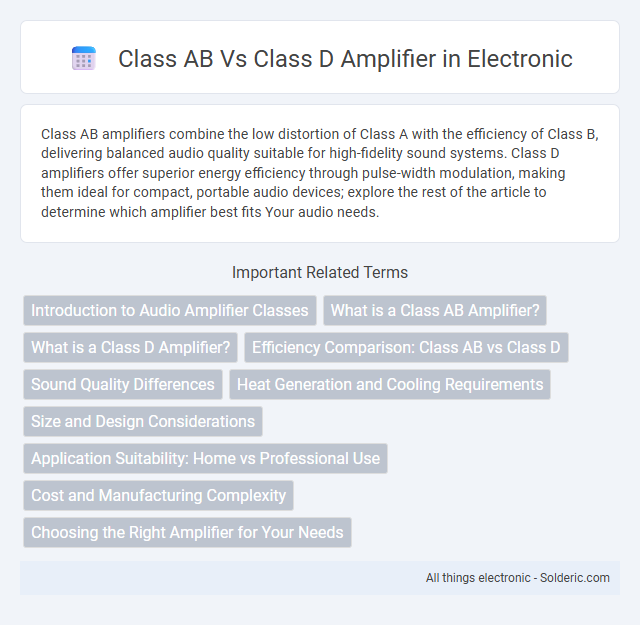Class AB amplifiers combine the low distortion of Class A with the efficiency of Class B, delivering balanced audio quality suitable for high-fidelity sound systems. Class D amplifiers offer superior energy efficiency through pulse-width modulation, making them ideal for compact, portable audio devices; explore the rest of the article to determine which amplifier best fits Your audio needs.
Comparison Table
| Feature | Class AB Amplifier | Class D Amplifier |
|---|---|---|
| Operation | Analog amplification with continuous conduction | Switching amplification using pulse-width modulation (PWM) |
| Efficiency | 50% to 70% | 85% to 95% |
| Heat Dissipation | High, requires large heat sinks | Low, minimal heat sinks needed |
| Sound Quality | High fidelity, low distortion | Good, but potential switching noise |
| Size | Relatively large due to heat sinks | Compact and lightweight |
| Cost | Moderate | Typically lower due to fewer components |
| Common Applications | High-end audio, guitar amplifiers | Portable devices, subwoofers, car audio |
| Complexity | Moderate | Higher due to switching circuits |
Introduction to Audio Amplifier Classes
Class AB amplifiers combine the low distortion of Class A operation with improved efficiency, making them suitable for high-fidelity audio systems requiring balanced performance. Class D amplifiers use pulse-width modulation to achieve high efficiency and compact size, ideal for portable and power-sensitive applications. Your choice depends on whether you prioritize audio quality or energy efficiency in your audio setup.
What is a Class AB Amplifier?
A Class AB amplifier combines the efficiency of Class B and the low distortion of Class A amplifiers by operating its output transistors slightly conductively at all times, reducing crossover distortion. It is commonly used in audio applications where balanced sound quality and power efficiency are essential. Your choice of a Class AB amplifier ensures both clear audio reproduction and moderate power consumption compared to other amplifier classes.
What is a Class D Amplifier?
A Class D amplifier operates using pulse-width modulation (PWM) or pulse-density modulation (PDM) to switch output transistors fully on or off, significantly increasing efficiency by minimizing power loss as heat. It typically achieves efficiency levels above 90%, making it ideal for battery-powered devices and high-power applications. Unlike Class AB amplifiers, which use linear amplification and continuously conduct current, Class D amplifiers rely on rapid switching and output filtering to reproduce audio signals with lower heat dissipation and compact design.
Efficiency Comparison: Class AB vs Class D
Class AB amplifiers typically achieve efficiency levels around 50-70%, balancing linearity and reduced distortion, making them suitable for high-fidelity audio applications. Class D amplifiers, also known as digital or switching amplifiers, boast efficiencies exceeding 90% by rapidly switching output devices on and off, minimizing power loss. Your choice between Class AB and Class D impacts energy consumption and heat generation, with Class D offering superior efficiency for portable and high-power audio systems.
Sound Quality Differences
Class AB amplifiers deliver superior sound quality with lower distortion and more accurate audio reproduction, making them ideal for audiophiles seeking clarity and warmth in music. Class D amplifiers, while highly efficient and compact, may introduce more harmonic distortion and slightly altered tonal characteristics due to their switching operation. Your choice depends on whether pristine sound fidelity or energy-efficient performance is a priority for your audio setup.
Heat Generation and Cooling Requirements
Class AB amplifiers produce more heat due to continuous conduction in output transistors, requiring robust heat sinks and active cooling for reliability. Class D amplifiers operate with high efficiency, generating significantly less heat and often needing minimal or passive cooling solutions. Lower heat output in class D designs reduces thermal management complexity and improves overall energy efficiency.
Size and Design Considerations
Class D amplifiers feature a compact design due to their high efficiency, allowing for smaller heat sinks and reduced overall size, making them ideal for portable and space-constrained applications. Class AB amplifiers require larger heat sinks and more circuit components to manage heat dissipation, resulting in bulkier designs that suit high-fidelity audio systems where sound quality is prioritized. The design complexity of Class AB amplifiers also leads to increased chassis size, whereas Class D amplifiers benefit from simplified layouts and PCB integration.
Application Suitability: Home vs Professional Use
Class AB amplifiers deliver high fidelity audio with minimal distortion, making them suitable for home audio systems where sound quality is prioritized. Class D amplifiers offer higher efficiency and compact design, ideal for professional applications requiring powerful output and reduced heat dissipation. Home users benefit from Class AB's audio clarity, while professionals prefer Class D for its performance in live sound and portable equipment.
Cost and Manufacturing Complexity
Class AB amplifiers have higher manufacturing complexity due to their combination of analog circuitry and biasing requirements to reduce crossover distortion, increasing component count and assembly time. In contrast, Class D amplifiers use digital switching techniques that simplify design and reduce heat sink needs, resulting in lower production costs. Overall, Class D amplifiers offer more cost-effective manufacturing and compact designs suitable for mass production.
Choosing the Right Amplifier for Your Needs
Class AB amplifiers provide a balanced combination of audio fidelity and efficiency, making them ideal for high-quality home audio systems and professional sound applications. Class D amplifiers excel in energy efficiency and compact design, perfect for portable devices and battery-powered equipment where power conservation and size are critical. Evaluating factors such as sound quality requirements, power consumption, and device size helps determine the most suitable amplifier class for specific audio projects.
class AB vs class D amplifier Infographic

 solderic.com
solderic.com